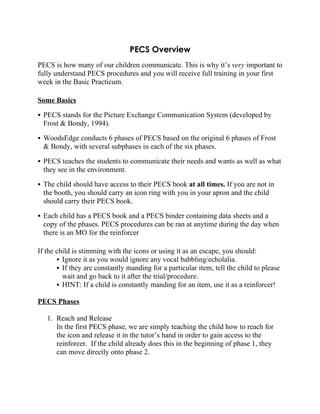
Pecs overview
- 1. PECS Overview PECS is how many of our children communicate. This is why it’s very important to fully understand PECS procedures and you will receive full training in your first week in the Basic Practicum. Some Basics PECS stands for the Picture Exchange Communication System (developed by Frost & Bondy, 1994). WoodsEdge conducts 6 phases of PECS based on the original 6 phases of Frost & Bondy, with several subphases in each of the six phases. PECS teaches the students to communicate their needs and wants as well as what they see in the environment. The child should have access to their PECS book at all times. If you are not in the booth, you should carry an icon ring with you in your apron and the child should carry their PECS book. Each child has a PECS book and a PECS binder containing data sheets and a copy of the phases. PECS procedures can be ran at anytime during the day when there is an MO for the reinforcer If the child is stimming with the icons or using it as an escape, you should: Ignore it as you would ignore any vocal babbling/echolalia. If they are constantly manding for a particular item, tell the child to please wait and go back to it after the trial/procedure. HINT: If a child is constantly manding for an item, use it as a reinforcer! PECS Phases 1. Reach and Release In the first PECS phase, we are simply teaching the child how to reach for the icon and release it in the tutor’s hand in order to gain access to the reinforcer. If the child already does this in the beginning of phase 1, they can move directly onto phase 2.
- 2. 2. Distance and Persistence In the second phase, the child is taught to walk further to get hand the icon to the tutor, and to be persistent in getting the tutor’s attention when handing them the icon. This is similar to what would happen in real life when the child wants to communicate with a parent and needs to walk over to them and get their attention. 3. Discrimination In this phase, the child is taught to discriminate between their PECS icons. More than one icon will be present on the book at a time, and the children will have to discriminate between non-preferred and preferred items, as well as between multiple preferred items. 4. Sentence strip In this phase the sentence strip is introduced to the book so the child must start each request with the “I want” icon, and then add the icon of the reinforcer that they would like. 5. Answering questions Students learn to use the sentence strip to answer the question “What do you want?”. 6. Tacting In this phase, the icon “I see” is added in the same column as the “I want” icon so that they child can label items as well as request them.